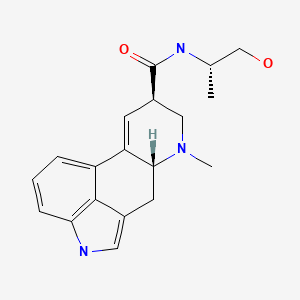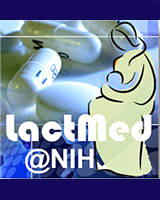Attribution Statement: LactMed is a registered trademark of the U.S. Department of Health and Human Services.
NCBI Bookshelf. A service of the National Library of Medicine, National Institutes of Health.
Drugs and Lactation Database (LactMed®) [Internet]. Bethesda (MD): National Institute of Child Health and Human Development; 2006-.
CASRN: 60-79-7

Drug Levels and Effects
Summary of Use during Lactation
Ergonovine is no longer marketed in the United States. Ergonovine given in the immediate postpartum period lowers serum basal prolactin and suckling-induced prolactin possibly increases. However, the prolactin level in a mother with established lactation may not affect her ability to breastfeed. Ergonovine appears to decrease the rate of breastfeeding. Ergonovine is probably best avoided in mothers who wish to nurse, relying instead on suckling-induced oxytocin release to hasten uterine involution.
Drug Levels
Maternal Levels. Relevant published information was not found as of the revision date.
Infant Levels. Relevant published information was not found as of the revision date.
Effects in Breastfed Infants
Relevant published information was not found as of the revision date.
Effects on Lactation and Breastmilk
In one study, a single oral dose of ergonovine maleate 0.2 mg in 12 nonbreastfeeding women on day 3 postpartum caused a 10 to 20% drop in average serum prolactin levels between 0.5 and 2.5 hours after the dose. The authors expressed concern that repeated doses of ergonovine could suppress lactation.[1]
Ten women who were given ergonovine 0.2 mg 3 times daily from day 1 to 7 postpartum were compared to 6 women who did not receive the drug. None of the women breastfed their infants. Serum prolactin levels were significantly lower in the treated women by day 2 postpartum and persisted through the 7 days of the study. Seven of the 10 treated women developed breast engorgement and had milk letdown and 3 had progressive inhibition of lactation. In 2 additional women who were nursing their infants, a single dose of 0.2 mg of ergonovine intravenously blunted the response of serum prolactin to suckling.[2]
In a nonrandomized study, 11 women with normal deliveries were given an intramuscular injection of either oxytocin 5 units plus ergonovine 0.5 mg (n = 5) or 5 units of oxytocin alone (n = 6). Serum prolactin levels were lower in the women given ergonovine from 0.5 to 2.5 hours.[3]
In a randomized, but nonblinded, controlled trial, women thought to be at low risk of postpartum hemorrhage were given either ergonovine 0.5 mg intravenously following birth of the infant (n = 197) or no drug (n = 135). Serum prolactin levels obtained in the period of 48 to 72 hours postpartum did not differ between the groups, but fewer of those who received ergonovine were still breastfeeding at 4 weeks postpartum than those who did not.[4]
A retrospective review of obstetrical records of 18,165 records of mothers giving birth in Wales found that use of intravenous or intramuscular ergonovine during the third stage of labor as a uterotonic reduced the odds of the mother breastfeeding at 48 hours postpartum. The reduction was 36% in the overall sample and 49% for primiparous mothers.[5]
Alternate Drugs to Consider
References
- 1.
- Shane JM, Naftolin F. Effect of ergonovine maleate on puerperal prolactin. Am J Obstet Gynecol 1974;120:129-31. [PubMed: 4602154]
- 2.
- Canales ES, Garrido JT, Zarate A, et al. Effect of ergonovine on prolactin secretion and milk let-down. Obstet Gynecol 1976;48:228-9. [PubMed: 940657]
- 3.
- Symes JB. A study on the effect of ergometrine on serum prolactin levels following delivery. J Obstet Gynaecol 1984;5:36-8.
- 4.
- Begley CM. The effect of ergometrine on breast feeding. Midwifery 1990;6:60-72. [PubMed: 2195299]
- 5.
- Jordan S, Emery S, Watkins A, et al. Associations of drugs routinely given in labour with breastfeeding at 48 hours: Analysis of the Cardiff births survey. BJOG 2009;116:1622-9. [PubMed: 19735379]
Substance Identification
Substance Name
Ergonovine
CAS Registry Number
60-79-7
Disclaimer: Information presented in this database is not meant as a substitute for professional judgment. You should consult your healthcare provider for breastfeeding advice related to your particular situation. The U.S. government does not warrant or assume any liability or responsibility for the accuracy or completeness of the information on this Site.
- User and Medical Advice Disclaimer
- Drugs and Lactation Database (LactMed) - Record Format
- LactMed - Database Creation and Peer Review Process
- Fact Sheet. Drugs and Lactation Database (LactMed)
- Drugs and Lactation Database (LactMed) - Glossary
- LactMed Selected References
- Drugs and Lactation Database (LactMed) - About Dietary Supplements
- Breastfeeding Links
- PubChem SubstanceRelated PubChem Substances
- PubMedLinks to PubMed
- Review Methylergonovine.[Drugs and Lactation Database (...]Review Methylergonovine.. Drugs and Lactation Database (LactMed®). 2006
- Review Chloramphenicol.[Drugs and Lactation Database (...]Review Chloramphenicol.. Drugs and Lactation Database (LactMed®). 2006
- Review Metaproterenol.[Drugs and Lactation Database (...]Review Metaproterenol.. Drugs and Lactation Database (LactMed®). 2006
- Review Intrauterine Levonorgestrel.[Drugs and Lactation Database (...]Review Intrauterine Levonorgestrel.. Drugs and Lactation Database (LactMed®). 2006
- Review Lisuride.[Drugs and Lactation Database (...]Review Lisuride.. Drugs and Lactation Database (LactMed®). 2006
- Ergonovine - Drugs and Lactation Database (LactMed®)Ergonovine - Drugs and Lactation Database (LactMed®)
Your browsing activity is empty.
Activity recording is turned off.
See more...
